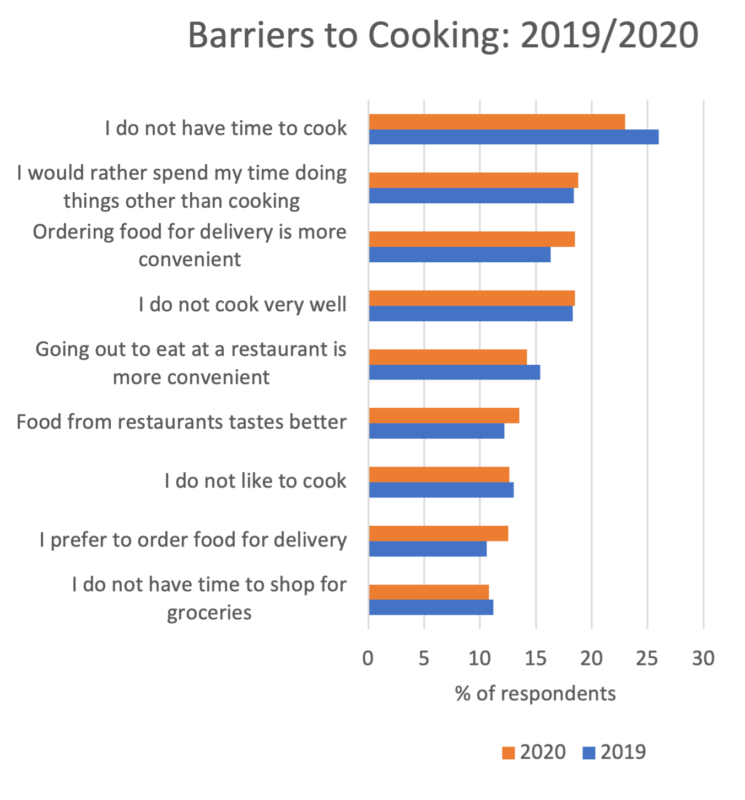Technology is not just changing where we eat, but what we eat. As the lines between foodservice and retail, at-home and away from home, continue to blur, more of our food will be prepared for us by others. This trend is leading to what Euromonitor International has dubbed, “The Era of Food on Demand.”
Coronavirus (COVID-19) has accelerated the development of this trend. With the pandemic forcing consumers everywhere to solve for a wider range of daily meal occasions, e-commerce has brought packaged food and prepared food into closer competition, serving many of the same daily occasions. According to Euromonitor International, the e-commerce share of all spending on food and beverage surpassed 10% in 2020, up from just 3% in 2015. This is driving a blurring of the lines between retail and foodservice, placing pressure on existing business models whilst creating space for entirely new ones. Over time, this will create more opportunities and demand for complete, prepared meals, delivered to order.
This is an enormous shift, easily on par with the mid-20th century emergence of highways/motorways and cold chains which fueled the rise of modern grocery retail and quick-service restaurants. The 20th century was about mass availability—the 21st is about the growth of on-demand availability, across every occasion, with fresh food accounting for more of this than ever.
To be clear, this future is far from assured—an age of fresh meals everywhere, all the time is predicated on hundreds of billions of dollars in infrastructure spending, along with a range of yet-to-be-achieved advances in automation, payments, food production, and others. Yet the amount of investment already underway is truly staggering—Amazon’s annual capital investment (of which fresh food distribution accounts for a growing portion) now routinely exceeds that of telecommunications and energy companies like ExxonMobil or AT&T, surpassing US$40 billion in 2020, according to company reports, as delivery demand surged. Meanwhile, many of the key trends driving the continued emergence of the Era of Fresh Food on Demand are accelerating:
Prepared meals everywhere
According to Euromonitor International’s Voice of the Consumer: Lifestyles survey fielded in 2020, 46% of consumers aged 30-44 ordered food via takeaway or delivery in 2020, up from 34% in 2019. Prepared meals are becoming a new focus for branding, profit, and differentiation across the global food industry. The rise of third party delivery and smartphone ordering enables producers of prepared meals (not just limited service restaurants, but full-service restaurants, meal kit producers, and others) to theoretically reach every consumer, at any time of day, without building out delivery capacity of their own.

The power of proximity
New facilities are bringing production and distribution closer to end consumers. Whilst consumers have long valued convenience, what is new is the speed at which technology is steadily ratcheting up consumer understanding and expectations of what is possible in terms of delivery. Same-day delivery has quickly given way to a host of concepts looking to provide a growing array of packaged and prepared food items in 30 minutes or less.
The new “meal fulfillment centers”
Lines are blurring between at-home and away-from-home channels as delivery expands. With the old model of grocery retail centred on regular consumer stock-up under attack from multiple approaches, freshly-prepared products for home consumption will become a larger component of what grocery retailers do, whilst simultaneously becoming a larger component of what restaurants do, as prepared food expands its share of all eating occasions.
Food and drink as fashion
The emergence of a far more delivery-optimised global food system will make far more occasions “cooking-optional.” Food prepared by others and delivered to the consumer will become price-competitive with more and more packaged food and drink categories. Liberated from daily food prep, more consumers will have time to ponder choices and desires. Food then becomes as much an expression of personal identity as what we wear, accelerating a process that has gained steam throughout the last 50 years.
Impulse, snacking occasions evolve as consumers make fewer shopping trips
For much of the 20th century, food and beverage brands have drawn significant profits from ensuring their product are readily available at “points of desire,” those moments when consumers are looking for a snack or a treat right now and are willing to pay for it. Delivery, however, completely reorders this geography—fewer trips to the supermarket (or convenience store) mean fewer impulse purchases overall, given the planned nature of many e-commerce purchases.
A changing discussion about health and sustainability
Packaged food and drink companies have come under immense pressure over the last 20 years regarding the content of their products, with comparatively less attention paid to many foodservice brands, with away-from-home dining still largely seen as an indulgence. As prepared, delivered meals account for more occasions, however, this is likely to shift, as are the offerings seen on third-party delivery services. What’s more, the expansion of delivered meals will inevitably lead to more attention from public health authorities.
How should companies respond?
Whether purchasing packaged ingredients or ordering in a restaurant, consumers are ultimately looking for meals—successful brands will be those able to target fresh, convenient meals towards a wide array of occasions. As freshly-prepared meals capture a larger proportion of total eating, the need for a compelling story of origins, craft, and ingredients becomes crucial. Likewise, as foodservice moves from an indulgence to a daily part of many consumers’ lives, the need for transparency only grows. Finally, as delivery and smartphone services become commodities available to any brand, the cost of new initiatives will fall further, favouring those brands able to launch and iterate quickly.


